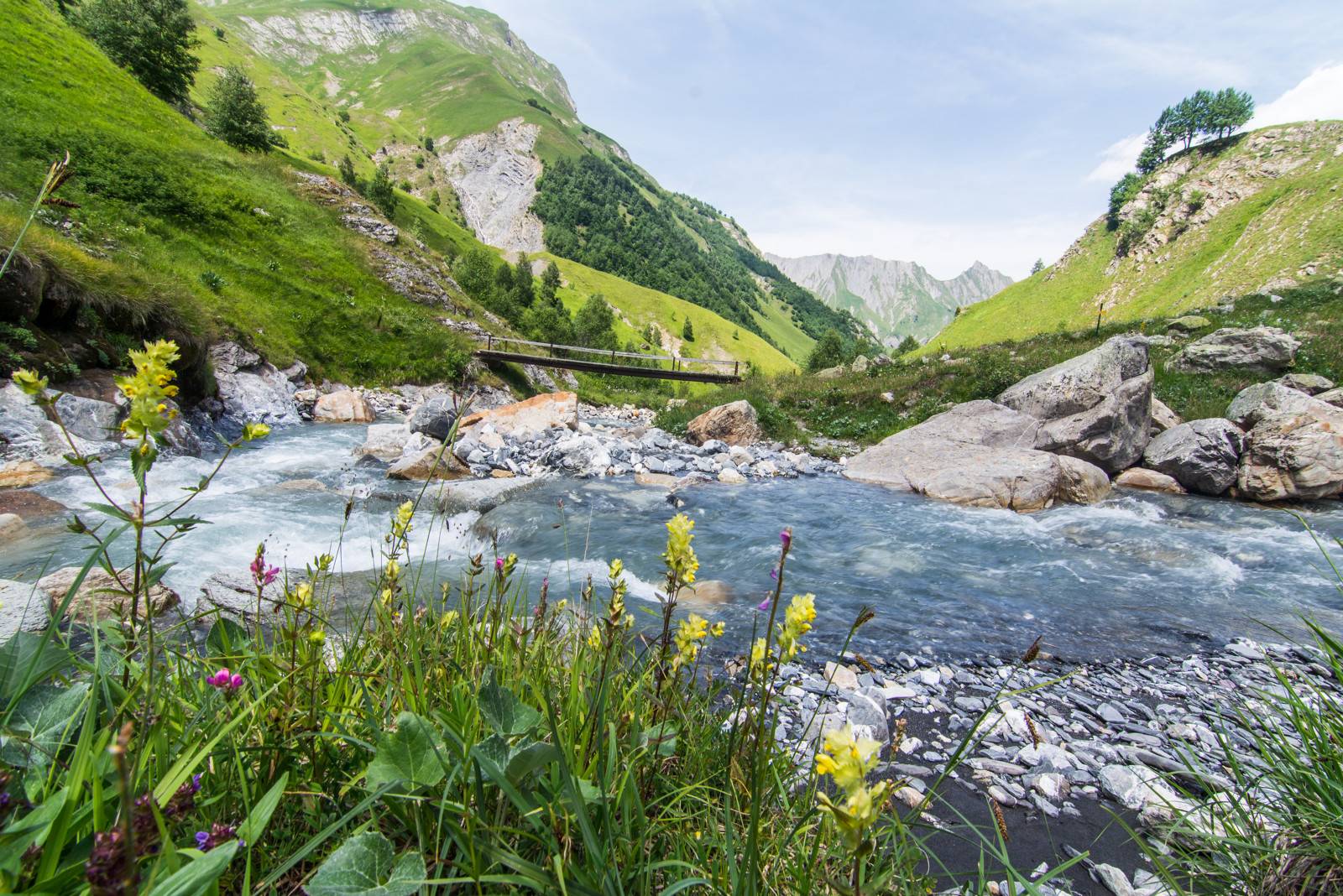
10-In discovery of the remarkable Vallée des Encombres
Woodland trail : 13 km
Description
Follow the green waymarks: Les Encombres.
E-bike rental shop:
Skiset Léo Lacroix
Secteur : La Croisette - Résidence Lac du Lou
+33 (0)4 79 00 28 15
- Departure : Saint-Martin-de-Belleville
- Arrival : Saint-Martin-de-Belleville
- Towns crossed : LES BELLEVILLE
Forecast
Altimetric profile
Recommandations
If in doubt, you can take an introductory lesson in how to ride an electric bike with an instructor.
If you see a herd ahead, slow down and go round it. If there is a patou, a guard dog, climb down from your bike and walk, pushing it alongside you. Avoid making any sudden or aggressive gestures towards the dog and move away from the herd slowly and calmly. The dog will only be checking that you do not pose a threat to its herd. Respect the parkland and close gates behind you after you've gone through them.
The mountain is living, please respect it by staying on the paths and tracks.
Information desks
Place de l'Eglise, 73440 Saint-Martin-de-Belleville
Transport
Also consider carpooling.
Access and parking
Parking :
Accessibility
- Emergency number :
- 114
10 points of interest

Musée de Saint Martin de Belleville - Matthieu_CELLARD  History
HistorySaint-Martin de Belleville Museum
Housed in an old farmstead in the village centre, Saint-Martin-de-Belleville Museum goes back over 150 years of Belleville valley history. An astonishing history which led this almost self-sufficient highland village towards a tourism-oriented destiny.
Through recreated scenes of traditional dwellings, videos and archive images, experience the captivating highlights of this picturesque village perched at an altitude of 1,450m. From farming life in the 19th century to the construction of Les Menuires and Val Thorens in the 1960s and '70s, watch as the valley has gradually become more industrialised. The museum naturally charts the pinnacle of this development - the opening of the village resort of Saint Martin and its affiliation to the 3 Vallées ski area, which brought a fresh wave of development to the municipality. There is a section dedicated to the 1992 Albertville Olympics. Les Menuires would host the Slalom races, which would further raise the valley's profile.
st-martin-belleville.com / 04 79 00 70 75
Open in the winter and summer season, daily except on Saturdays. Between seasons, open by request, enquire at the Maison du Tourisme
Adults €3 / Free for under 16s / Guided tour and storytelling for children depending on the activity programmes, available at the Tourist Office
Audioguides available in English.
Patrimoine de Saint Martin de Belleville - CCCT  Small heritage
Small heritageHeritage trail
In Saint Martin de Belleville, the heritage trail is an ideal way to explore the old village of Saint Martin, its monuments and sites central to community life in the past. Setting off from the parish church, there are a dozen or so stages for delving into the history of Saint Martin.
Enjoy an interactive sightseeing experience with the QR-codes to scan and view photos and commentary on the sites you pass. If you don't have a smartphone or tablet, you can get a free map with a summary of the main points from the Maison du Tourisme.
5km circular route, with elevation gain of 40m.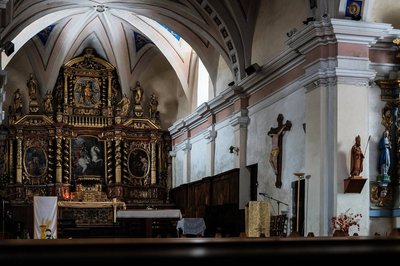
Eglise de Saint Martin de Belleville - Matthieu_CELLARD  History
HistorySaint Martin de Belleville Church
The origins of this church predate 1606. It was rebuilt and extended in the 17th century. Its understated exterior contrasts with the gold and colours of the altarpieces. In the middle of the altarpiece on the high altar, sculpted by an artist from Valsesia, is a painting of St Martin sharing his cloak. The church contains the tomb of the Blessed Paul, a Spanish pilgrim who set out to cross the Alps in 1721 and whose statue lies along the footpath leading to Le Lou lake.
This chapel is open to visitors all year round. Weekly tours organised by an experienced guide with the FACIM (Foundation for International Cultural Action in the Mountains) during the winter and summer seasons.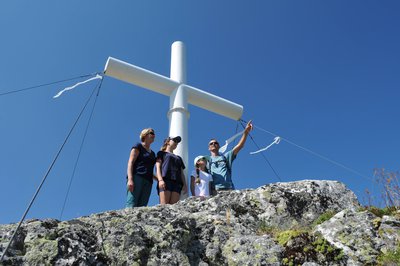
La Croix des prisonniers - CCCT  History
HistoryThe Prisoners' Cross
From Saint-Martin you can glimpse the Prisoners' Cross which overlooks the village from Mont Cochet. It was erected on 26 June 1955 by Belleville locals in memory of the 31 prisoners and soldiers who returned home safe and sound at the end of World War II.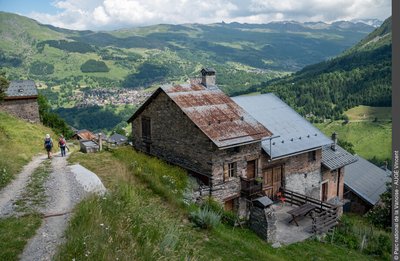
La Gittaz - Vincent AUGE  Architecture
ArchitectureHamlet of La Gittaz
Like a number of others in the Vallée des Encombres, this hamlet was occasionally inhabited all year round, although living conditions in winter were extremely harsh. Its name originally meant a temporary dwelling, usually in the mountains, for use at the beginning and end of the summer season. Hence, it is the equivalent of “remue” or “chalet”.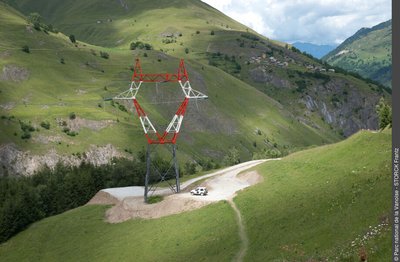
Réseau électrique sur la rive du torrent des Encombres - Frantz STORCK  Water
WaterHydroelectricity
Hydroelectricity has marked the Tarentaise’s history and landscape. From the late 20th century onwards, its development has supported industrial activity in the Valley and tourism in its villages and resorts.
Many of the Vallée des Encombres’ springs have been taken in hand, supplying the EDF’s tunnel running beneath your feet to the La Coche dam before the water is turbined in Moûtiers.
Above ground, the high-voltage power line is there for all to see, and has been carrying electricity from Albertville (La Bathie) to Italy since 1971.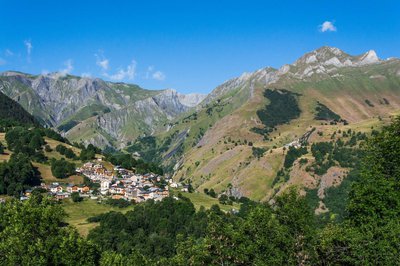
Vallée des Encombres - Vincent Lottenberg  History
HistoryThe Vallée des Encombres
The Vallée des Encombres (which might be translated as “Valley of Obstructions”) takes its name from the area’s major avalanche activity. The archives preserve the memory of an avalanche that swallowed up some of the village’s inhabitants while they were making their way to attend mass in the chef-lieu. The exodus that took place after 1850 depopulated the mountains and their isolated villages were abandoned. The hamlet of La Gittaz (pronounced “La Gitte”), located at the entrance to the Valley, suffered the same fate as Planlebon. Sunnier and accessible by car, the village was finally restored.
The hamlets of Les Priots and Gittamelon were also restored. However, they were only ever inhabited in the summer, during which they were steps on the Encombres road, which was then a major thoroughfare connecting La Maurienne with Moûtiers. In those days, all journeys were made on foot, with mules to carry the loads. Can you imagine the Valley travelled by hawkers and merchants come to buy Belleville cheeses, pilgrims on the road to Notre Dame de la Vie, and stockbreeders taking their herds to the far-famed fair in Saint-Martin?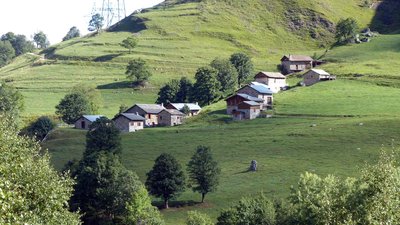
Les Priots - Jean-Claude VILLIEN  Architecture
ArchitectureHamlet Les Priots
Lying below the trail, the hamlet of Les Priots' houses are typical of the architecture to be found in the Tarentaise’s mountain areas. In the local patois a “priot” is a little highland meadow. There is little or no forestland here, so chalets cannot be built of wood, which is reserved for carpentry and window and door frames. Consequently, stones and stone slates are the main materials employed, resulting in houses and roofing of largely mineral composition. Walls are often entirely of stone, bonded by mortar made from a mixture of lime and sand, although earth mortar is occasionally to be found in older buildings. In order to support the weight of such edifices, the first floor is provided with a vault set on one or more central pillars, depending on surface area, with more support pillars incorporated into or set against the walls. The vault also protects the house against fire as well as helping to keep in the heat. The vaulted room serves as a stable and houses the family during the winter. It is accessed through a door that is usually orientated southwards or facing the slope and is used by people and animals alike. Windows are small in order to avoid heat loss and also because there used to be a tax levied calculated on the size of a house’s windows. Above the vaulted stable is the barn, with a double door large enough to admit a mule and its load opening on the street side. Flooring laid out just behind the door is used to thresh cereals. The rest of the ground is roughly levelled out using grilla (or gria, the local name for a kind of plaster made from gypsum rock, a mineral common in the area). Some houses boast a second, smaller door, used by family members going out to find food for the animals in winter. The barn has two floors, the upper floor being known as the “solan” (because it is exposed to the sun). It is separated by a loose wooden floor. Large dormers in the walls, open to the outside or simply slatted, let in the draughts required for drying and storing cereals.

Conservatoire de l'abeille noire - aptv_redac  Fauna
FaunaBlack Bee Conservatory
The black bee (Apis mellifera mellifera) is a subspecies of the domestic bee. Savoie’s ecotype has adapted to the climate and local flora and is used by the Valley’s apiarists. The creation of a black bee conservatory in the Vallée des Encombres in April 2016 included setup of breeding apiaries ensuring that young queens were only fertilised by males of the same ecotype. There’s a breeding apiary consisting of small-size hives on the spot where the trail leaves the Route des Encombres and takes you down to Les Priots. The power line that runs just above them doesn'tt seem to disturb their inhabitants.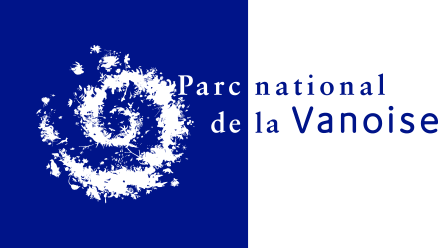
 History
HistoryLegend of Caseblanche: The phantom herd
“A hunter by the name of Joseph-Antoine stopped off at the Caseblanche high mountain chalet (arbé) one foggy evening and used the few logs left there to make a fire for himself. He had barricaded the door with a tree stump, saying to himself as he grew warmer, “Even the Devil couldn't get in here now!” Around midnight, although there couldn’t have been anybody living nearby in that season, he was woken up by the sound of a herd approaching, cowbells a-jangle, accompanied by a party of “montagnards”, who set about milking their cows. They chopped wood, fed the fire, washed the dishes… The herd seemed to have gone on its way… But more and more herdsmen flocked into the chalet, sitting themselves down at table and filling their bowls with curds. “They’re eating”, he said to himself, “and after they’ve finished, perhaps they’ll get back to their work and leave me in peace”. But suddenly he heard a sharp, nasal voice from down below, drowning out the clattering of their spoons: “Hey there, we’re forgetting that funny young fellow asleep up there! We must make him a bowl of curds like all the rest”. When he heard those words, Joseph-Antoine’s hair stood on end. Without even taking the time to put his shoes on, he leapt out of bed in terror, ripped up a floorboard, jumped down and fled to the village as fast as his legs would carry him, without taking any notice of the voices calling him back. The shoes he left at the chalet were never found, nor was his hat, which he lost in his flight. The devil had doubtless kept them as his spoils.”
Told by Joseph Marcoz, Le Villard des Allues, November 1964, in "Récits et contes populaires de Savoie”, Gallimard, 1980.
